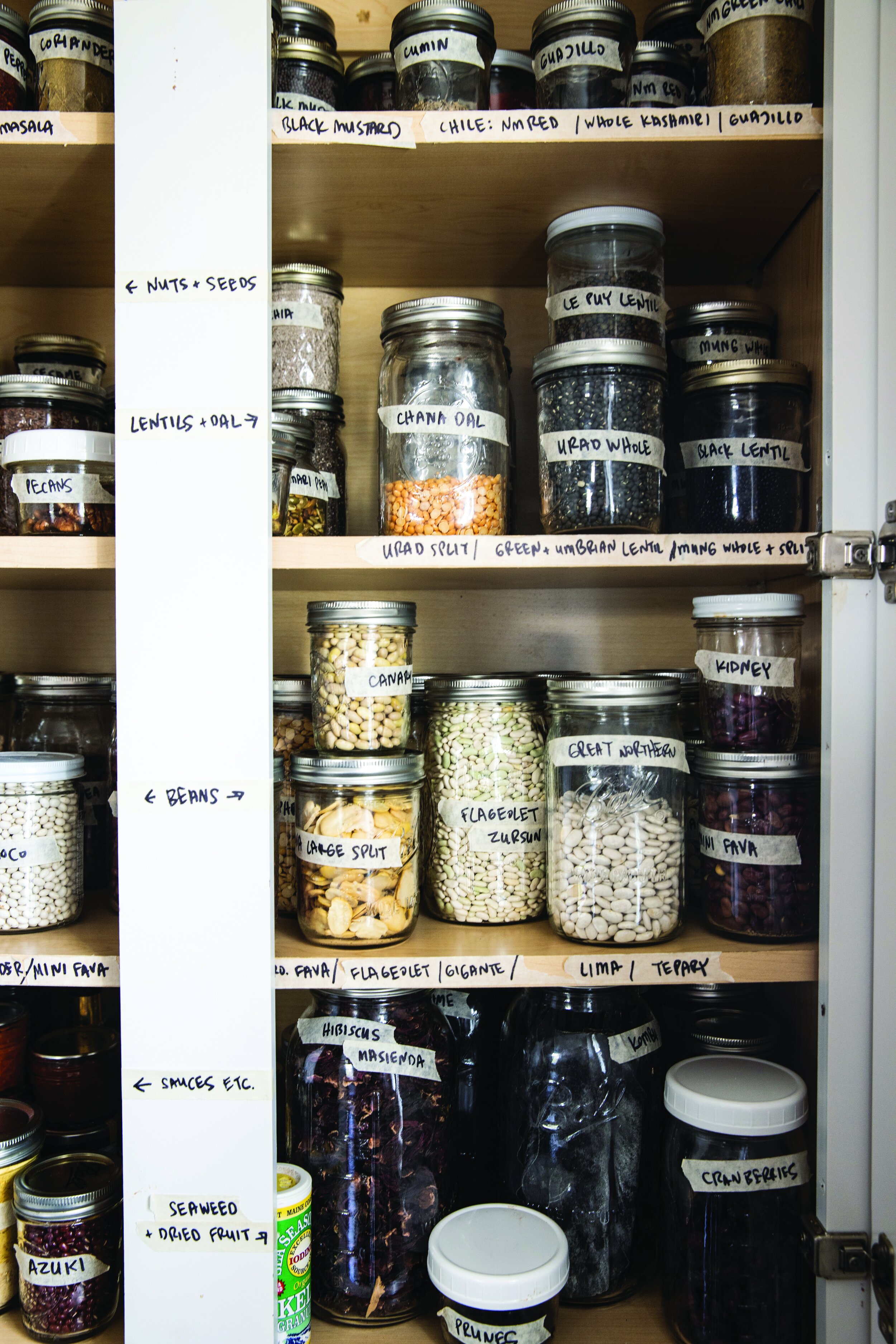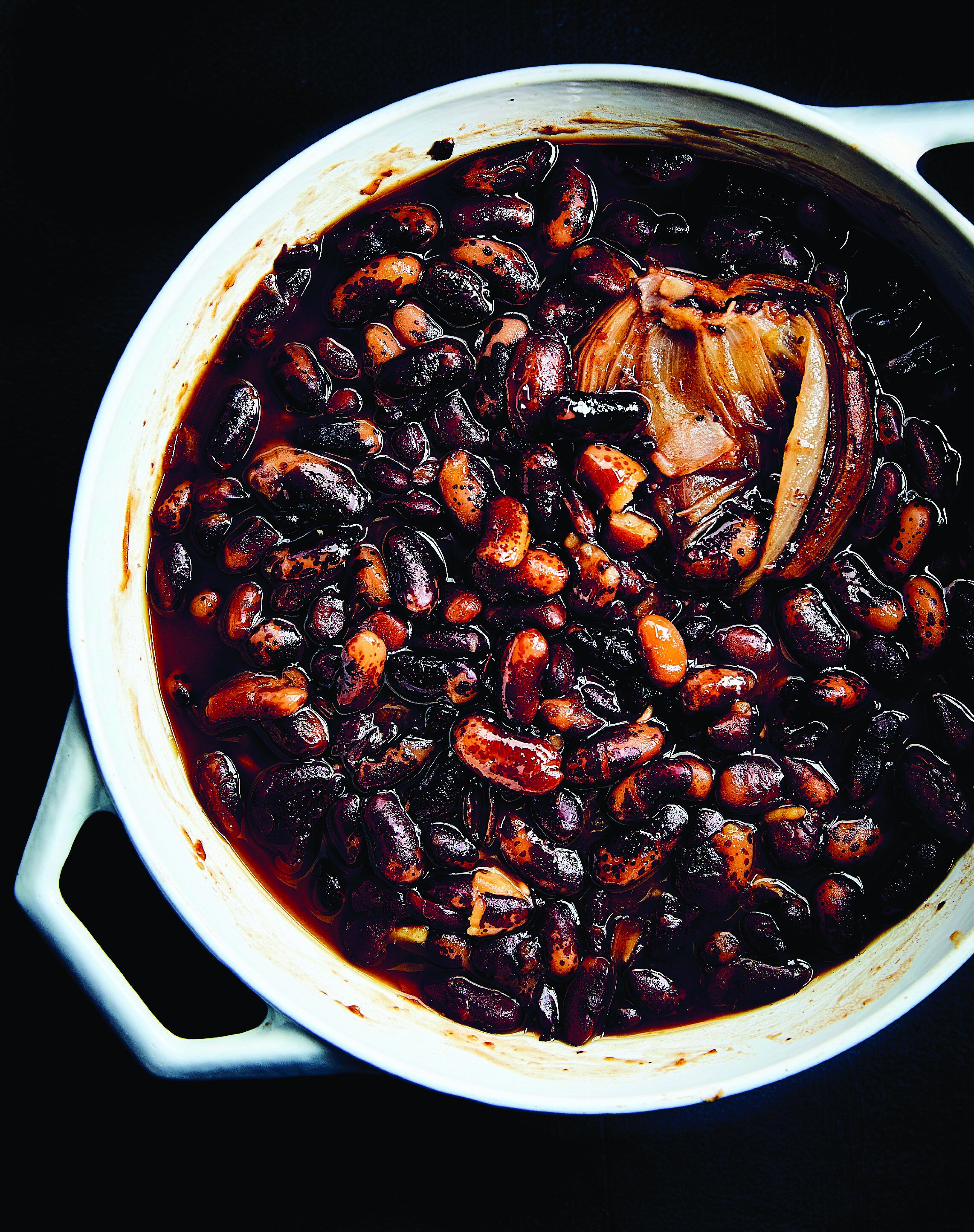Washington Post’s Joe Yonan is Full of Beans
/Delicious “Homesteader Beans” from his new cookbook, Cool Beans
Washington Post’s Joe Yonan in his kitchen. He recently published Cool Beans: The Ultimate Guide to Cooking With the World’s Most Versatile Plant-Based Protein. Photo by Jennifer Chase.
By Joe Yonan | From the Edible DC Spring 2020 Issue
Open my refrigerator and you’ll find a quart-size Mason jar or two of, say, cooked chickpeas, black turtle beans or cranberry beans, immersed in their cooking liquid, awaiting whatever use I have in store for them. In my freezer might be zip-top bags of cooked (or farm-fresh) Jacob’s cattle beans and black-eyed peas, along with stews, soups, and purées I’ve made with them. On my stove—or in my Instant Pot—might just be the next pot simmering away.
In my pantry are more than a dozen jars of dried beans and lentils in a multitude of colors and sizes. And I always keep on hand several cans of this bean or that, for those times when I’m caught without home-cooked versions at the ready.
I’ve liked beans since my childhood, when chants about “the magical fruit” tickled me and my friends. In my college days, paying my own way and poor as the dickens, I depended on cans and bags of black, pinto and kidney beans (along with instant ramen noodles) to get by. I spent a few decades also eating meat, but as a vegetarian for the last eight years (and plant-centric for many years before that), I’ve doubled down on my commitment to beans in as many guises as I can find—or create.
Forward-thinking cooks have been talking about ancient grains for years now, but some beans are just as old. Pythagoras talked about fava beans, Hippocrates about lupinis and one particularly famous orator is even more deeply connected to chickpeas: His family took its name (Cicero) from the legume’s genus (Cicer).
For much of the world, beans have always been a way to sustain through times of poverty, as the cheapest (by far) source of protein around. And now, with a growing interest in plant-based eating even among people who can afford to eat whatever they want, beans have become more appealing than ever.
They are truly unique, as the only food that can be categorized, according to the U.S. Department of Agriculture (USDA), as both a protein and a vegetable. What’s more, according to a 2016 study published in the journal Food & Nutrition Research, meals based on these vegetable proteins are more satisfying than those based on animal proteins. They’re nutrient-dense, rich in cancer-fighting antioxidants and heart-healthy fiber, and they have been shown to help improve our gut health, help stabilize blood sugar and possibly even lower cholesterol.
Joe Yonan’s pantry, ready for bean action and more. Photo by Jennifer Chase.
When cooked from dried, with precious few other ingredients added, they create a rich broth to rival anything that ever came from boiling a chicken. They freeze beautifully in this liquid, making them perfect for make-ahead, finish-quickly meals. They’re pretty darn good straight from a can. And they can play into every kind of dish, in every part of the meal.
My own bean journey took a turn about a decade ago, when I first learned of the heirloom beans sold by Rancho Gordo in Napa, California. We at the Washington Post were the first national publication to write about this bean missionary who started to get attention in the food world when famed chef Thomas Keller put Steve Sando’s beans on his menu at the French Laundry. I started buying Sando’s beans, and I can remember the revelation of those first few pots: The varieties I was familiar with were outstanding representatives, cooking up so much more quickly and evenly, no doubt because they were simply fresher, and presenting me with flavor complexities I had never experienced tasting beans.
These days, I draw inspiration from traditional bean recipes from all over the world, including the giant-bean stews of Greece; the bean-stuffed breads of Georgia; the chickpea-and-bread soup of Tunisia; and so many more. As the longtime food editor at the Post, I see all the trends and recipes bubbling up in the food world, from bloggers and authors and chefs and home cooks, and I love how the way people are treating beans today in some cases has very little to do with tradition. There are riffs on the soccas and farinatas of France and Italy that combine them with mushrooms and whole chickpeas for gorgeous flavor, color and texture. There are lovely gluten-free cakes made with puréed cooked beans in place of flour and some of the fat, recipes that remind me of the old diet standby of black beans and chocolate cake mix to make brownies—but are so much better. There are even cooks using aquafaba, the liquid from canned or cooked beans, to make dishes for which you formerly needed eggs: meringues, mousses and mayos, not to mention the leavening power this aquafaba provides cakes, muffins and more.
As far as I’m concerned, it’s obvious: Anything meat can do, beans can do better.
Edited excerpt from Cool Beans: The Ultimate Guide to Cooking With the World’s Most Versatile Plant-Based Protein, With 125 Recipes, by Joe Yonan (Ten Speed Press, 2020).
The recipe for Homesteader’s New England Baked Beans is below. We have two other delicious bean recipes for you, Red Gem Lettuce with Green Curry Goddess with Crispy Lentils and Falafel Fattoush.
HOMESTEADER’S NEW ENGLAND BAKED BEANS
8 servings
On my sister Rebekah and brother-in-law Peter’s Maine homestead, the copy of Woodstove Cookery: At Home on the Range by Jane Cooper isn’t just dog-eared, it’s cleaved in two, broken apart at page 144 because of Pete’s regular use of the baked beans recipe, which he prepares in the wood-fired brick bread oven he built outside. Cooper credits this recipe to Leila MacGregor of Tunbridge, Vermont, who in turn calls it “an old Vermont family recipe.” Besides preferring to use home-grown beans (Jacob’s cattle variety beans are particularly good for this treatment), Peter’s only deviation is in the sweetener: he uses slightly less molasses than the original recipe calls for and maple syrup (of course) instead of sugar. I take the sweetener down a touch more and add a little vinegar for brightening—plus smoked paprika to approximate the work of the traditional salt pork. Oh, and in keeping with the bean-cooking techniques taught to me by Rebekah (and later proven true by America’s Test Kitchen), I put in a little kombu to help soften the beans during their first cooking. Yes, these are twice-baked—first until tender with little other seasoning and then veeeeeerrrrrry slowly with the spices and sweeteners. If you want to shortcut it, use a pressure cooker for the first go and a slow cooker for the second—or an Instant Pot, in two rounds, for the whole shebang. To be even more authentic, fire up the wood oven and/or use a stoneware bean pot.
Ingredients
1 pound Jacob’s cattle or other plump creamy beans, such as cranberry/borlotti or pinto
Water
2 (3 by 5-inch) strips kombu (dried seaweed)
1 small yellow or white onion, sliced
1/4 cup molasses
1/3 cup maple syrup
2 teaspoons kosher salt, plus more to taste
2 teaspoons dry mustard
1 teaspoon Spanish smoked paprika (pimenton)
1/2 teaspoon ground ginger
1/4 teaspoon freshly ground black pepper
2 tablespoons apple cider vinegar, plus more to taste
Preheat the oven to 350 º F.
Combine the beans with enough water to cover by 2 inches in a Dutch oven or other large pot over medium-high heat. Add the kombu. Bring to a boil, turn off the heat, cover, and transfer to the oven. Bake until the beans are very tender, 60 to 90 minutes, checking a time or two to add water if they are no longer covered by it.
Remove the kombu and reduce the temperature to 200 º F. To the pot add the onion, molasses, maple syrup, salt, mustard, paprika, ginger, and pepper and bake for 8 hours, until the beans are falling-apart tender and infused with flavor. Stir in the vinegar, taste, and add more vinegar and salt if needed.
Serve hot, either as a side dish or over roasted potatoes and with a garden-fresh salad for a true Maine homesteader’s meal. Cover and refrigerate for up to 1 week, or freeze for up to 3 months.
Joe Yonan is the Food and Dining editor of The Washington Post, supervising food coverage in the features department. He is the author of the new cookbook "Cool Beans" (Ten Speed Press, February 2020), the editor of "America The Great Cookbook" (Weldon Owen, 2017) and has written two other cookbooks for Ten Speed: “Eat Your Vegetables” (2013) and “Serve Yourself" (2011). He writes The Post's Weeknight Vegetarian column.







